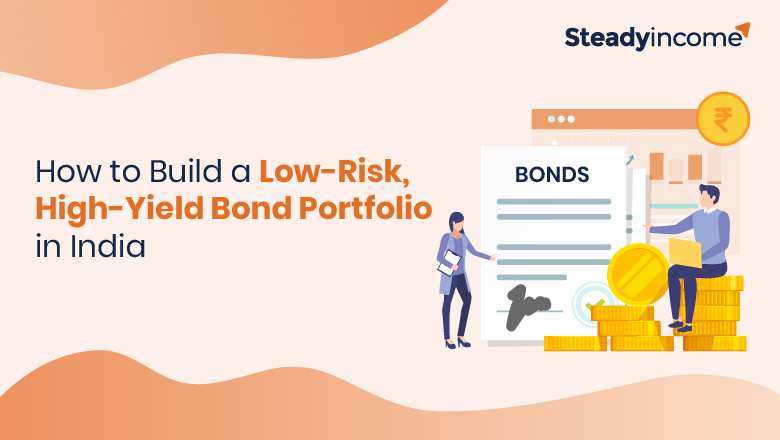How to Build a Low-Risk, High-Yield Bond Portfolio in India

Investing in bonds is one of the most reliable ways to generate stable and predictable income while minimizing risk. In India, bonds offer an excellent opportunity for investors seeking low-risk, high-yield investments. However, building a well-balanced bond portfolio requires careful selection, diversification, and strategic planning.
This guide will explore how to construct a low-risk, high-yield bond portfolio in India, ensuring financial stability and consistent returns.
Understanding Bonds as an Investment Option
Bonds are fixed-income securities issued by governments, corporations, and financial institutions to raise capital. Investors who purchase bonds lend money to the issuer for a fixed period, earning periodic interest payments and receiving the principal amount upon maturity.
Types of Bonds in India
1. Government Bonds (G-Secs & Treasury Bills)
-
-
- Issued by the Government of India and the Reserve Bank of India (RBI).
- Considered the safest investment option with minimal default risk.
- Best suited for conservative investors looking for stable returns.
-
2. Corporate Bonds
-
-
- Issued by private and public corporations to fund business operations.
- Offer higher returns than government bonds but come with some level of credit risk.
- Credit ratings assigned by agencies like CRISIL, ICRA, and CARE help assess risk levels.
-
3. Tax-Free Bonds
-
-
- Issued by government-backed organizations such as NHAI, IRFC, and REC.
- Interest income is entirely tax-exempt, making them attractive for high-income investors.
-
4. Non-Convertible Debentures (NCDs)
-
-
- Corporate-issued bonds that provide higher interest rates than traditional fixed deposits.
- Can be secured (backed by collateral) or unsecured (higher risk).
-
5. Sovereign Gold Bonds (SGBs)
-
-
- Issued by the Government of India, linked to the price of gold.
- Provide fixed interest rates along with potential capital appreciation.
-
6. State Development Loans (SDLs)
-
-
- Issued by state governments to finance development projects.
- Offer slightly higher yields than central government bonds with moderate risk.
-
Building a Low-Risk, High-Yield Bond Portfolio
1- Diversification for Stability
Diversifying across different types of bonds is the most effective way to reduce risk while optimizing returns. A well-balanced portfolio may include:
-
-
- Government bonds for security and stability.
- Corporate bonds for higher returns.
- Tax-free bonds for tax efficiency.
- Sovereign Gold Bonds for inflation protection.
-
By spreading investments across various bond categories, investors can mitigate the impact of market fluctuations and default risks.
2- Assessing Credit Ratings
Credit ratings indicate the financial health of a bond issuer and the likelihood of repayment. Higher-rated bonds are safer, while lower-rated bonds offer higher yields but come with increased risk.
-
-
- AAA-rated bonds: Highest safety, suitable for risk-averse investors.
- AA and A-rated bonds: Moderate risk with slightly better yields.
- BBB and below: High-risk investments with higher returns but potential default risks.
-
Investors should focus primarily on AAA and AA-rated bonds to ensure a low-risk portfolio.
3- Implementing a Bond Laddering Strategy
Bond laddering involves investing in bonds with different maturity periods, allowing for regular income and better liquidity. A diversified bond ladder can include:
-
-
- Short-term bonds (1-3 years) for immediate liquidity.
- Medium-term bonds (3-7 years) for balanced returns.
- Long-term bonds (7-15 years) for higher yields and capital protection.
-
This strategy ensures that some bonds mature at different intervals, providing investors with periodic cash flow while minimizing reinvestment risks.
4- Investing in Inflation-Protected Bonds
Inflation can erode purchasing power over time, affecting real returns. Inflation-linked bonds (ILBs) adjust interest payments based on inflation rates, ensuring that investors maintain their purchasing power.
The Government of India periodically issues inflation-indexed bonds that can be a good addition to a low-risk portfolio.
5- Exploring Bond Mutual Funds and ETFs
For investors looking for professional management, bond mutual funds and exchange-traded funds (ETFs) offer diversified exposure to various bonds. These funds:
-
-
- Provide access to a mix of government and corporate bonds.
- Offer liquidity, as they can be bought and sold on exchanges.
- Reduce the effort required for individual bond selection.
-
Popular categories of bond funds in India include:
-
-
- Debt mutual funds (short-term, medium-term, and long-term).
- Gilt funds (invest in government securities).
- Corporate bond funds (focus on high-quality corporate debt instruments).
-
6- Tax Efficiency in Bond Investments
Tax considerations play a crucial role in determining net returns. Investors can maximize post-tax earnings by selecting tax-efficient bond options.
-
-
- Tax-free bonds provide completely tax-exempt interest income.
- Sovereign Gold Bonds provide tax exemption on capital gains if held until maturity.
- Long-term capital gains (LTCG) benefits apply to certain bonds, reducing tax liabilities.
-
Understanding the tax implications of different bonds can help investors optimize their returns.
Best Low-Risk, High-Yield Bonds for Indian Investors
- Government Bonds (G-Secs & T-Bills) – Risk-free, backed by the Government of India.
- AAA-rated Corporate Bonds – These offer slightly higher yields with low credit risk.
- Tax-Free Bonds – Ideal for high-net-worth individuals seeking tax-efficient returns.
- RBI Floating Rate Bonds – Adjust interest rates based on market fluctuations, ensuring stable returns.
- State Development Loans (SDLs) – These offer competitive interest rates with government backing.
By carefully selecting a combination of these bonds, investors can create a portfolio that balances safety with attractive returns.
Key Takeaways for Bond Investors
- Diversification across different bond types reduces risk and enhances returns.
- High credit-rated bonds ensure stability and minimize default risks.
- Bond laddering provides liquidity at different intervals.
- Inflation-linked bonds help maintain real purchasing power.
- Tax-efficient bonds maximize post-tax earnings.
A well-structured bond portfolio can provide financial security, consistent passive income, and protection against market volatility.
Conclusion
Investing in a low-risk, high-yield bond portfolio requires strategic planning, diversification, and risk assessment. By selecting high-quality bonds, maintaining a diversified investment approach, and incorporating tax-efficient strategies, investors can achieve stable financial growth while minimizing risks.
For investors seeking reliable bond investment opportunities, platforms like Steadyincome offer curated options tailored to different risk preferences and financial goals. Start building your bond portfolio today to secure a stable financial future.


